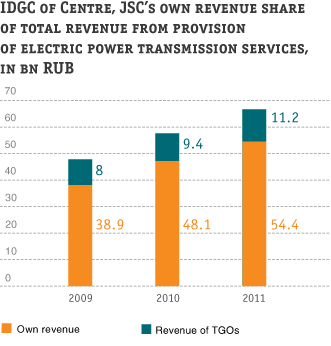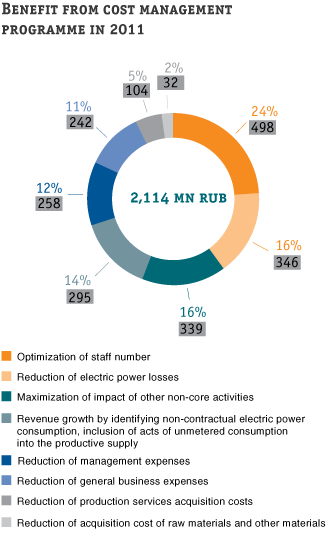Electric power transmission
In 2011, the volume of electric power transmission services provided by the Company (within the Company’s boundary of demarcation for balance sheet attribution) amounted to 56.664 bn kWh. A surplus of electric power supply from the grid of 1.14% over the 2010 figure was caused by growing electric power consumption by consumers in the reporting year.
Volume of services provided for electric power transmission, in physical data:
| Indicator | 2009 | 2010 | 2011 | Growth rate, % | |
|---|---|---|---|---|---|
| 2010/2009 | 2011/2010 | ||||
| Volume of electric power transmission services provided within boundary of demarcation of branches of IDGC of Centre, JSC for balance sheet attribution, mn kWhkilowatt-hour | 53,129.2 | 56,028.9 | 56,667.4 | 5.46 | 1.14 |
| Volume of electric power transmission services provided through supply points to end-users (“joint operation” circuit), mn kWh | 50,845.1 | 53,355.8 | 54,087.2 | 4.94 | 1.37 |
In 2011, the total revenue of IDGC of Centre, JSC amounted to RUB 68.13 bn, of which revenue from electric power transmission services accounted for RUB 65.67 bn, or 96.4%.
Throughout the period 2009–2011, stable growth has been observed both in the Company’s total revenue and in electric power transmission proceeds. In the reporting year revenue from electric power transmission grew 14.1% in comparison with 2010.
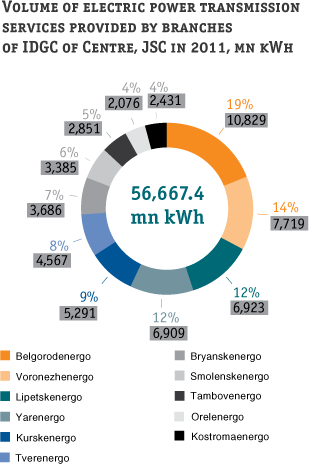

Electric power transmission tariffs, with which this revenue conforms, are set by the state regulatory bodies the Federal Tariff Service of the Russian Federation (to be known from now on as FTS of RussiaFederal Tariffs Service of the Russian Federation) and Regional Energy Commissions (REC).
Before 2009, a tariff-setting method called “cost plus” was used by all grid organizations. On January 1, 2009, IDGC of Centre, JSC began to introduce the new Regulatory Asset Base (RAB) system. As of January 1, 2011, all Company branches had switched over to this tariff-regulation system.
FTS of Russia sets the following:
- tariffs for electric power transmission services and boundary (minimum and/or maximum) levels, including tariffs for electric power transmission within the Unified National (All-Russia) Electric Grid;
- boundary (minimum and/or maximum) tariffs for electric power transmission within grids belonging to regional grid organizations.
Setting unified (“joint operation”) tariffs for electric power transmission services lies within the competence of the executive bodies of Russian regional governments dealing with state tariff regulation.
In 2007–2008, a new settlement system for electric power transmission services was implemented in the area of operations of IDGC of Centre, JSC . Under this scheme, Company branches are considered “joint operation-keepers” in all 11 Russian regions in which they operate. Electric power consumers (providers of last resort, retail energy suppliers, and consumers with direct contracts) settle their accounts for electric power transmission services with the Company’s branches at these unified (“joint operation”) tariffs.
The Company distributes the monetary funds it accrues to territorial grid organizations (TGOs) at individual tariffs for electric power transmission services, which are approved for settlements between two grid organizations. Likewise, Company branches make payments for electric power transmission services to territorial grid organizations, for which individual tariffs have been set.
In this context it is also worth mentioning IDGC of Centre, JSC’s own revenue, which in 2011 came to RUB 54.4 bn (or 82.9%), a rise of 13.2% since 2010.
This positive growth dynamic is a result of increases in the productive supply of electric power and tariff growth in 2011.
Weighted average “joint operation” tariffs for electric power transmission services in 2009–2011, in kopeks/kWh:
| Indicator | 2009 | 2010 | 2011This data uses the latest approved tariffs (in accordance with Government Decree No. 1172 On the Approval of Rules for the Wholesale Electric Power and Capacity Market and on the Introduction of Amendments into Certain Regulations of the Russian Federation Government for the Organization of Electric Power and Capacity Wholesale Market Functioning, December 27, 2011) | Growth rate % | |
|---|---|---|---|---|---|
| 2010/2009 | 2011/2010 | ||||
| Weighted average “joint operation” tariffs for electric power transmission services | 91.80 | 111.22 | 126.6 | 21.2 | 13.8 |
Along with the growth of Company income from its primary activity, expenditure for electric power transmission services also increased in 2011: in the reporting year base costs for electric power transmission amounted to RUB 54,912 bn (and base costs net of TGO payment to RUB 43,689 bn).
Base costs for electric power transmission in 2009–2011, in bn RUB:
| Indicator | 2009 | 2010 | 2011 |
|---|---|---|---|
| Base costs in core activities | 42.73 | 50.47 | 54.91 |
| NON-CONTROLLABLE EXPENSES | 22.62 | 29.69 | 32.78 |
| Payment for Unified National Electric Grid (UNEG) services | 7.84 | 11.01 | 12.84 |
| Payment for services of third-party grid companies | 8.01 | 9.44 | 11.22 |
| Compensation of losses | 6.78 | 9.23 | 8.72 |
| CONTROLLABLE EXPENSES | 20.11 | 20.79 | 22.14 |
| Materials, electric power for production needs | 1.76 | 1.99 | 2.33 |
| Production work and services | 1.90 | 0.95 | 0.88 |
| Salary expenses | 5.79 | 7.32 | 7.67 |
| Charges on the salary fund | 1.38 | 1.85 | 2.55 |
| Other expenses in the prime cost | 9.28 | 8.68 | 8.71 |
| Base costs net of TGO payments | 34.71 | 41.03 | 43.69 |

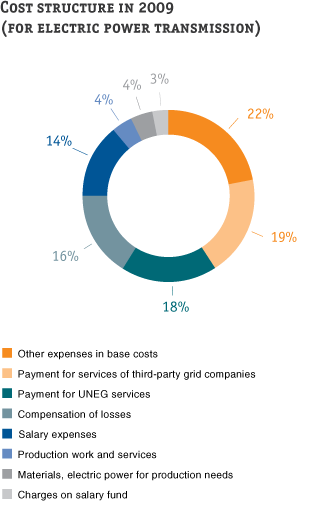
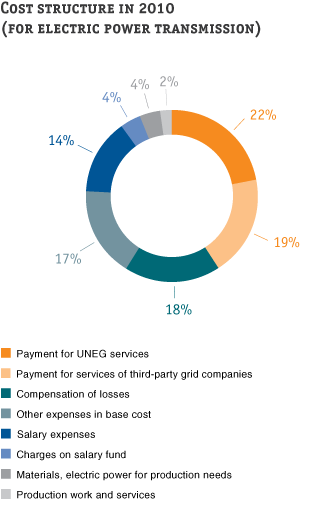
The rise in 2011 of base costs in the Company’s primary activity, electric power transmission, was determined by several factors:
- non-controllable expenses (up RUB 3.09 bn, or 10%, on 2010)
grew mainly due to a price increase for Unified National Electric Grid (UNEG) electric power transmission services (up RUB 1.82 bn, or 17%) and electric power transmission services of third-party grid companies (up RUB 1.78 bn, or 19%) which was caused by a rise in the the set tariffs. At the same time expenses for indemnification of losses in 2011 (down RUB 0.51 bn, or6% ) were successfully reduced by decreasing the price for the purchase of losses as compared to 2010; - controllable expenses (up RUB 1.35 bn, or 6.5%)
grew mostly due to increases in the cost of materials and electric power for production needs of more than 16% as compared to 2010.
In comparison with the previous year, a growth in salary expenses (up RUB 0.35 bn, or 5%) and charges on the salary fund (up RUB 0.70 bn, or 38%) is noted. This was connected with rising staff salaries in 2011 and the readjustment of pay scales to comply with the branch staff schedule (BSS) and with the transfer of more than 400 staff from OOO “ATP Energiya” to Belgorodenergo branch.
Some of the expenses in this regard (for production work and services) were offset due to Belgorodenergo branch’s becoming able to service vehicles in-house (giving a reduction of RUB 0.07 bn, or 7%).
Spending on electric power acquisition for indemnification of electric power losses are one of the main articles of the Company’s costs. In 2011, losses amounted to 9.93% of electric power supply to the grids. RUB 8.72 bn were spent on indemnification of these losses.
Dynamics of electric power losses in 2009–2011:
| Indicator | 2009 | 2010 | 2011 | 2011/2010 |
|---|---|---|---|---|
| Electric power losses, actual, in % | 10.11/9.93Adjusted for invoicing of non-contractual consumption | 10.01 | 9.93 | −0.08 p.p. |
| Electric power losses, planned, in % | 9.96 | 10.03 | 9.93 | — |
In this regard, in 2011, electric power losses were reduced by 0.08 percentage points in comparison with 2010.
In 2011, the percentage of productive high-voltage supply increased, which automatically also meant lower power losses.
In 2011, the Company also did a substantial amount of work on identifying and invoicing unmetered and non-contractual consumption. The reduction of electric power losses has achieved in the Company by the implementation of several measures. Detailed data on the size of losses and the measures aimed at reducing them, as well as information on the volume of energy resources used by the Company in 2011, is set out in Appendix 3 of this report.
Aggregate data on the effectiveness of measures for the reduction of electric power losses in 2011:
| Measure | Annual loss reduction due to the respective measures taken, in K kWh |
|---|---|
| Measures, total: | 206,543 |
| including: | |
| Organisational | 175,544 |
| Technical | 8,635 |
| Improvement in metering systems | 22,364 |
In 2011, the Board of Directors of the Company approved a Programme for Energy Conservation and Raised Energy Efficiency (Minutes of the Meeting of the Board of Directors No. 09/11 of April 18, 2011) (to be referred to as the Programme). The Programme aims to lower the consumption of energy resources for business needs and rto reduce technological electric power losses during transfers.
In the reporting year, the Company has successfully achieved the targets set in the Programme.
The implementation of measures to cut electric power losses led, in 2011, to a lowering of such losses by 206.5 mn kWh (an improvement on the planned reduction of 130.9 mn kWh). In cost terms, the Programme resulted in savings of RUB 641.6 ml being made ,almost twice as much as the planned RUB 384.2 mn. The 2011 results give the cost of implementing the Programme as RUB 2,286 mn, with financing from the IDGC of Centre, JSC’s investment programme.
In 2011, the programme for cost management brought benefits of RUB 2,114 bn.
This saving was made in the following areas:
- Revenue growth (through identifying non-contractual electric power consumption, including certificates of unmetered consumption in the productive supply and a programme of prospective development for power metering systems) — bringing benefits of RUB 295 mn.
- Reducing the cost of buying raw materials and other inputs (by lowering spending norms for materials, reusing materials, and applying competitive tendering) — bringing benefits of RUB 32 mn.
- Reducing electric power losses (as a result of installing automated information and measuring systems for commercial energy metering and taking steps to eliminate unmetered and non-contractual electric power consumption by users) — benefits of RUB 346 mn.
- Reduction of production service acquisition costs (by selecting contractors for a range of equipment use and other services by competitive tender— benefits of RUB 104 mn.
- Optimising spending on staff (through overtime savings and improving incentivisation schemes) — benefits of RUB 497 mn.
- Lowering general business expenses (through a reconsideration of contract conditions for IT services, communications services, and consultancy services) — benefits of RUB 242 mn.
- Lowering management expenses (by reducing management bonuses) — benefits of RUB 258 mn.
- Maximization of the impact of other (non-core) activities (by selling non-core assets, and recovering fines, charges and penalties for violation of contract conditions by counterparties of subsidiaries and affiliates) — benefits of RUB 338.9 mn.



